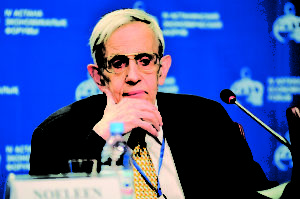
John Forbes Nash, Jr. (June 13, 1928 – May 23, 2015), courtesy of Wikimedia Commons user Economicforum, CC BY-SA 3.0.
Few outside of math and economic circles knew the name John Nash before the 2001 movie A Beautiful Mind starring Russell Crowe arrived in theaters. Based on the 1998 book of the same title, the story of a genius who also battled mental illness struck a chord with audiences, winning four Academy Awards, including Best Picture.
However, the man behind the movie was so much more than the biopic could cover. His contributions to game theory, differential geometry, and partial differential equations have provided tremendous insight into the forces that govern complex systems in daily life. His theories have reverberated through the years and are still being used today in market economics, evolutionary biology, computing, artificial intelligence, politics, and military theory. In 1950, the Proceedings of the National Academy of Sciences published a very brief paper by Nash that would change the way many studied economics and eventually earn him the Nobel Memorial Prize in Economic Sciences.
Dr. Nash and his wife, Alicia, died on May 23 in a car wreck. He was 86, and his wife was 82. The movie and book about his life helped lift the 1994 Nobel Prize winner to a household name outside of those in economics. But for those already in the know, Dr. Nash’s impact on economic science is still being felt 65 years after he published his influential paper.
His idea, the “Nash equilibrium,” changed game theory and altered the way economists and mathematicians looked at the world. John von Neumann invented game theory in the 1930s as a way of modeling strategic behavior between rational adversaries, but Von Neumann’s theory only concerned zero-sum games between two participants who have no common interests; in these situations, one participant’s loss is the other’s gain. However, zero-sum situations are uncommon in real life.
In 1949, as a young student at Princeton studying for his doctorate, Nash developed a way to model the strategic behavior of multiple players in any game, whether it was zero-sum or not. He showed that even if they were not collaborating explicitly, there would be at least one equilibrium where each player could maximize his or her own benefit, assuming that the other players also act to maximize their self-interest. A Nash equilibrium exists when no player has an incentive to deviate from the chosen strategy, since no player can choose a better strategy given the choices of the other players. Importantly, a Nash equilibrium isn’t necessarily the best outcome for anyone, as the Prisoner’s Dilemma is often used to demonstrate. It simply means that no individual can improve his or her position, given they’re unable to change others’ choices.
Greenfield Advisors Director of Economic Research Dr. Clifford Lipscomb talked about how Dr. Nash influenced him in school and later in his career.
“I was in my senior year at Berry College when I first learned of the Prisoners’ Dilemma,” Dr. Lipscomb said. “Then, in graduate school at Georgia Tech, the movie A Beautiful Mind came out. I remember seeing it in the theatre on a date with my then girlfriend (and now wife) Amelia. Right after that, we found ourselves in a bookstore and I found a book that had Dr. Nash’s dissertation. Writing my own dissertation at the time, which was almost 200 pages, I was astonished to see that his dissertation was less than 30 pages. It was chock full of mathematical equations with very little supporting text. It was his later writings where a researcher could find more supporting text to explain those complicated equations. His work shaped several generations of researchers on important topics in game theory and other disciplines.”
While Dr. Nash’s contributions to economics can’t be overstated, it’s important to note that he always thought of himself as a mathematician. Dr. Lipscomb explains the role of mathematics and statistics in his role at Greenfield Advisors.
“We deal with statistics and other mathematical formulas every day here at Greenfield Advisors,” said Dr. Lipscomb. “While the clarity of the written products we produce is driven by our audiences (attorneys, governments, homeowners, other experts), sometimes expressing things in mathematical formulas, with adequate written explanation, is the simplest way to communicate an idea. We always try to balance the use of lots of mathematical equations with the amount of explanation required so that our audience understands the methods we are using.”
You can read more about the life of Dr. Nash and how his work on game theory has helped develop thinking about environmental regulation.
Please share your thoughts and memories of Dr. Nash in the comments. How did he shape your career?






Recent Comments